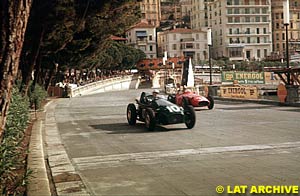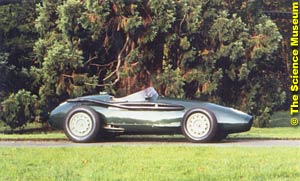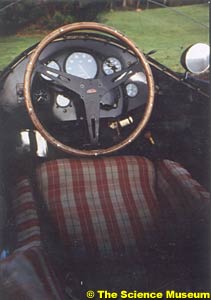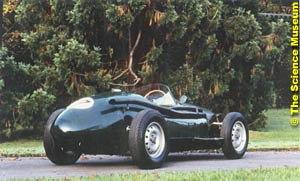
Remembrance of Things Fast
Atlas F1 Senior Writer
There once was a team called Connaught. It was a small team, but it was very much admired - still is, by many motor racing fans. The story of Connaught, and the seven years it participated in motor racing, including Formula One, is a fascinating one, and very typical of Grand Prix racing as it was then, and as it is now. Thomas O'keefe researched the highs and lows of the marque and presents a four-part series of articles about the unique constructor.
As Connaught entered the 1957 season, the disappointments mounted. The much-anticipated arrival of the Climax Godiva V8 engine never materialized and the deadlines set by financial backer Ken McAlpine to find other investors had long since expired. Clarke continued fielding cars - separate two-car teams, one for the UK and one for the Continent - for the non-Championship races in April 1957 to bring in the cash awarded to entrants as starting money.
At the Pau Grand Prix in France on, April 22nd 1957, the Connaughts did somewhat better as a team, with Ivor Bueb placing third in B5 and Les Leston finishing fifth in B2. On the same day as the Pau race, at Goodwood for the Glover Trophy, Rodney Clarke fielded B3 for Stuart Lewis-Evans, B4 for Jack Fairman and B7 for Archie Scott-Brown.
The Connaught B3 driven at Goodwood by Lewis-Evans was re-bodied as yet another variation on the streamlined Connaught body theme, the so-called "Toothpaste Tube" Connaught, which had a wedge shape and a swooped up tail that made it most distinctive looking. The Toothpaste Tube was so new that it had not yet been painted and appeared in the original bare aluminum when Lewis-Evans ran it in the race. With Beginner's Luck, Stuart Lewis-Evans survived the retirements of the Vanwalls of Moss and Brooks to win the race for Connaught. Fairman placed second in B4 as the BRM and Vanwalls retired. Scott-Brown also retired in the B7 as he had all too frequently. When you consider that Clarke was pressed for funds and living from race purse to race purse it is remarkable that he was still able to innovate and win with the Toothpaste Tube Connaught and place 1, 2 at that.
One week later, the Naples Grand Prix was held in Posillipo, Italy, and Lewis-Evans was up to second in his Connaught B5 until his hub broke on lap 44 of the 60 lap race, a remarkable performance when it is remembered that Ferrari was represented by a three-car team at this race, driven by Hawthorn, Collins (both in Lancia-Ferrari's) and Musso in an F2 Ferrari.
After the mixed results of these non-Championship races in April 1957, Rodney Clarke entered two Connaughts for the Monaco Grand Prix - the Toothpaste Tube version of B3 for Stuart Lewis-Evans, and B2 for Ivor Bueb, in the slipper-bodied style. Early in the race, Moss crashed his Vanwall at the entrance to the chicane and the Lancia-Ferrari's of Collins and Hawthorn crashed just after the exit of the chicane trying to avoid the Vanwall.
After the Connaught team returned to Surrey from the 1957 Monaco Grand Prix, Rodney Clarke had to face the financial facts of life: with Ken McAlpine unwilling to continue to provide funds and the starting purses being too small to support an ongoing operation, Clarke made what must have been the heart-breaking decision to put Connaught on the auction block.
On September 17th 1957, when, in a good year, the Connaughts would have been returning home to England from the Italian Grand Prix at Monza - won, gallingly, by the competition, Vanwall - the Connaught team cars known as B2, B3, B5, B6, and B7 were offered for sale at Send, with the purchase price including a "standard pre-race rebuild"; some of the Connaught cars offered were not sold at the auction. Bernie Ecclestone bought B3 and B7. The auction catalogue owned by Mike Oliver shows that Bernie paid £1,950 for B3 (lot 290) and £2,100 for B7 (lot 287). Although Stuart Lewis-Evans had now moved on to Vanwall for the 1958 Championship season joining Moss and Brooks, he was then being managed by Bernie Ecclestone, and Lewis-Evans and Roy Salvadori ran Bernie's two Connaughts over the 1957-58 winter in the Tasman series in New Zealand before the 1958 season began in earnest.
On April 4th 1958, back from New Zealand (Bernie recalls that "we raced them successfully there"), Bernie ran his two privateer Connaughts in the Glover Trophy at Goodwood, with Stuart Lewis-Evans in B3 and Archie Scott-Brown in B7. Lewis-Evans finished fifth and Scott-Brown sixth, a reasonably good finish for these dated cars in a field that included Mike Hawthorn in a Ferrari Dino 246 and Jack Brabham and Roy Salvadori in the newly-ascendent rear-engined Cooper-Climax T45's.
Monaco 1958: Bernie Takes The Wheel
Later on in 1958, a truly unique event occurred when 27 year-old owner-driver Bernie Ecclestone attempted to qualify the by now completely outclassed Connaughts he bought at auction in September 1957. On May 18th 1958, at the Monaco Grand Prix, Bernie made his first qualification attempt in the Connaught, and he tried again to qualify the car at the British Grand Prix at Silverstone. Bernie's recollection today of his attempt to qualify at Monaco is (uncharacteristically) dim: "I believe it was the first time I sat in the bloody car," he told Atlas F1, "there wasn't a lot of hope."
Ironically, Bernie recently was quoted as saying that he now misses running a team. He told the Daily Telegraph in February 2001 that "basically, at heart, I am still a racer. To be honest with you I would probably rather be running McLaren or Ferrari rather than doing what I am doing. They get more satisfaction than I can get because after each race they know how they've done. They've got a result. My result is whether we are commercially successful. It's satisfying but perhaps not so satisfying."
Connaught: The Marque That Refused To Die
But Connaught was not finished Grand Prix racing just yet, notwithstanding the auction. Rodney Clarke had developed a prototype lightweight spaceframe car called the C8 with a revised de Dion rear end and inboard rear brakes, which failed to find any takers at the 1957 auction but which was sold a month later with some of the remaining assets of Connaught to Paul Emery, an inventive constructor of various Emeryson 500cc Formula 3 and Formula 2 cars. Emery completed the C-Type and entered it in the inaugural US Grand Prix at Sebring, Florida, on December 1959, where it was driven by Boris Said and finished dead last. As Said recollects his very short race, he hit the brakes when he got to the end of the straightaway on lap 1, the brakes locked up, never unlocked and he crashed.
Even farther afield, in 1960 and 1961, Sam Tingle, a Grand Prix driver from Zimbabwe, raced Connaught A4 in South Africa. The provenance of Connaught A4 is fascinating and it may well be the most traveled of the extant A-Types, from England to Europe to Africa and back again, owned by Englishman, Americans, Belgians and South Africans along the way.
That other well-traveled Connaught, the one-off C-Type, made one further appearance in the United States, at Indianapolis of all places, when Boris Said's Sebring car, which had been acquired by a consortium headed by Tony Densham, made an unsuccessful attempt to qualify for the 1962 Indy 500 with Jack Fairman at the wheel. Indianapolis Motor Speedway historian Donald Davidson says other Brickyard regulars such as Bill Cheesebourg, who did not have a ride that year, tried to get the car up to qualifying speed but, like Fairman, also failed. Unloved and unsuccessful, in Europe, in Florida and now in Indiana, the C-Type and the Connaught line was finished racing at long last. Or was it?
Epilogue For a Proud Marque: Where Are They Now?
Having had several leases on life already, the increasing popularity of historic racing in modern times has made these old Connaughts sought after again. And they are competitive, it seems. In the most recent Goodwood Festival of Speed, Speedvision's Alain de Cadenet was leading a historic Grand Prix race in his 2.5 litre B-Type Syracuse style Connaught before spinning out; at Monaco, in another historic event, the same Connaught ran second.
As indicated, all the Connaught Grand Prix cars ever built came down to this: nine A-Types, seven B-Types and one C-Type. Seventeen in all. The Connaught J5 or D-Type prototype was built as a mock-up but was then abandoned and eventually junked when the much-ballyhooed Coventry-Climax Godiva V8 failed to materialize. The cars were constantly evolving even within a series: the A-Types series ended up with longer wheelbase versions as the last two built, AL9 and AL10; the B-Types had multiple body styles, including the streamliner with the dorsal fin, the "Toothpaste Tube" streamliner and the predominant slipper-bodied body style epitomized by the Syracuse Connaught.
The National Science Museum in London has custody of B6 where it is a part of the Museum of Transportation's Collection. This was a car that Rodney Clarke had repossessed from Piero Scotti when Scotti defaulted on his installment payments. According to Anthony Prichard in Thoroughbred & Classic Cars, August 1975 edition, the B6, originally the Scotti car, was unsold at the auction and was subsequently "loaned" to the Science Museum, although "its ownership has been disputed."
Indeed, in the course of a recent review of the Science Museum Technical File and my interview with McAlpine it was revealed that when McAlpine discovered that the Science Museum did not have the car on display some decades ago he asked for it back. But the Science Museum refused, citing the terms of the "loan", which apparently turned into a permanent "gift" to the Science Museum if the car was not taken back after 10 years. The compromise is that Connaught B6 is now out of storage and is on display at the National Motor Museum at Beaulieu. So you see, the Chancellor of the Exchequer did ultimately get his return on that involuntary "investment" made back in the Fifties. And, in the end, McAlpine got what he wanted too: that the car should be shared with the public. "We are quite proud of [the Connaught]," he said. "It would be nice if at least one was maintained where the public or enthusiasts or anybody else could see it."
Tom Wheatcroft's Donington Grand Prix Collection near Derby also has on display one Connaught A-Type, the indefatigable Connaught A3, still in its Rob Walker colors as raced by Tony Rolt, along with one B-Type, chassis B7, owned by the late Paul Morgan, the "mor" of Ilmor - the company that designed the McLaren engine for Mercedes-Benz.
Alain de Cadenet's Connaught is B2, the much-raced and consistently fast car often driven by Archie Scott-Brown in its prime; according to de Cadenet, B2 came with a complete logbook of its history, including testing and racing. Among its more prominent logbook entries is that B2 was the team car that went to Sicily that day in 1955 when Tony Brooks in B1 won the Syracuse Grand Prix. As indicated above, legend has it that Tony Brooks's B1 was destroyed by fire two years later in the 1957 Grand Prix of Sicily, but its engine survived (the fire was in the rear of the car).
There are no known examples of the streamliner body styles still extant or of the distinctive "Toothpaste Tube" Connaught B3 that took Stuart Lewis-Evans to his fourth place at Monaco in 1957.
The much traveled C8 that was part of the inaugural US Grand Prix at Sebring in 1959, is no longer lost somewhere in America but has been returned to England and to its original specifications and has joined de Cadenet's B2 in historic racing.
In addition the historic racing Connaughts, there are several others that appear occasionally, one of which was recently offered for auction, an A-Type denominated chassis "AX", one of the original short chassis A-Types, which was raced by Peter Hall at Goodwood in September 2000. The Connaught was expected to bring £100,000-125,000 at auction, considerably more than the approximately £2,000 Bernie paid for B3 and B7 at the September 1957 liquidation of Connaught.
In September 1999, another vestige of the dream that was Connaught disappeared when the factory building at Send in which all those Connaughts were built was demolished to make way for a modern office development project owned by real estate developer John Walker. Even the passage of 44 years from the time of the Tony Brooks historic 1955 Syracuse Grand Prix victory in Connaught B1 had not erased the significance of what the plucky little Connaught outfit managed to accomplish that day.
In recognition of the significance of what had been achieved by Connaught at the Send factory, before the wrecking ball had at it, the developer paid homage to Connaught with a celebratory lunch on site and invited former Connaught drivers and team members to mark the event. Even some of the Connaught cars were on display including the eye-popping Belgian Yellow A4 campaigned so vigorously by Belgian Johnny Claes in 1953. Motor Sports account of the Connaught farewell luncheon and of Connaught's significance to motor racing had a fitting Battle of Britain ring to it: "Never was so much achieved in top line motorsport by so few with so little."
And what of Rodney Clarke and Mike Oliver, who suffered through the Fabulous Fifties of Formula One to make a go of it with Connaught?
Rodney Clarke went back into the motor trade at Guildford and died in 1979. Mike Oliver, ex-RAF , became chief test pilot for Folland Aircraft. On October 23rd 2000, on the 45th anniversary of Tony Brooks's win at Syracuse, McAlpine, Oliver, Tony Brooks and many others involved with Connaught, gathered back at the site of the old Send factory, again at the instance of site developer John Walker who has now joined the ranks of dyed-in-the-wool Connaught enthusiasts, even to the point of commissioning a painting by Tony Smith to memorialize Tony Brooks's victory.
It was a small firm, but there were those that loved it. And still do...
In addition to thanking Ken McAlpine, Mike Oliver, Alain de Cadenet and Martin Stretton for their gracious cooperation in the preparation of this series, the author wishes to express his gratitude to Sam Evans, Assistant Curator of the Science Museum's Transportation Collection, and to Rhiannan Sullivan of the Science Museum's Picture Library for access to the Museum's Technical File and permission to use pictures of Connaught Chassis B6 in this article. The Science Museum is on Exhibition Road in London. At the Syracuse Grand Prix in Sicily, the British Vanwall team (which was now emerging as the leading British marque) joined the Connaughts, with Ivor Bueb in B5 and Les Leston in B1, the car that Tony Brooks had driven to his historic all-British victory in October 1955. Sadly, B1 was to be destroyed in a fire during this race when a broken rear half-shaft ruptured the fuel tank which was located right above the axle and a fire broke out. Thus, chassis B1 had returned to Syracuse, the scene of the greatest victory for Connaught and B1 and it had all gone up in smoke, somehow fitting for the ill-starred House of Connaught. B5 finished fifth, five laps behind the Lancia-Ferrari's of Peter Collins and Luigi Musso which finished 1-2.
At the Syracuse Grand Prix in Sicily, the British Vanwall team (which was now emerging as the leading British marque) joined the Connaughts, with Ivor Bueb in B5 and Les Leston in B1, the car that Tony Brooks had driven to his historic all-British victory in October 1955. Sadly, B1 was to be destroyed in a fire during this race when a broken rear half-shaft ruptured the fuel tank which was located right above the axle and a fire broke out. Thus, chassis B1 had returned to Syracuse, the scene of the greatest victory for Connaught and B1 and it had all gone up in smoke, somehow fitting for the ill-starred House of Connaught. B5 finished fifth, five laps behind the Lancia-Ferrari's of Peter Collins and Luigi Musso which finished 1-2.
 As the three young Englishmen hiked back to the pits, Fangio in his Maserati 250F then took the lead, with Brooks in the remaining Vanwall putting on a spirited chase. Masten Gregory, in his first Grand Prix, finished third in his Maserati 250F (Chassis No. 2511) and Lewis-Evans brought the No. 10 Toothpaste Tube Connaught - now painted - into fourth place in the Monaco Grand Prix, albeit three laps down to Fangio's Lightweight Maserati 250F (Chassis No. 2528). Although it could not have been known at the time, this was to be the last time the Connaught team would finish in the points in a Championship Grand Prix.
As the three young Englishmen hiked back to the pits, Fangio in his Maserati 250F then took the lead, with Brooks in the remaining Vanwall putting on a spirited chase. Masten Gregory, in his first Grand Prix, finished third in his Maserati 250F (Chassis No. 2511) and Lewis-Evans brought the No. 10 Toothpaste Tube Connaught - now painted - into fourth place in the Monaco Grand Prix, albeit three laps down to Fangio's Lightweight Maserati 250F (Chassis No. 2528). Although it could not have been known at the time, this was to be the last time the Connaught team would finish in the points in a Championship Grand Prix.
 Both times Ecclestone failed to get into the race but he has done well since! Interestingly, when Bruce Kessler tried to qualify Bernie's car at Monaco he failed too as did Paul Emery, another owner and constructor of lower formula cars, who tried to qualify the other Connaught. At Silverstone, Jack Fairman managed to qualify one of Bernie's cars and Ivor Bueb qualified the other but ultimately went out with mechanical trouble. It would be another twelve years before Bernie could face owning a team again, when he bought Brabham from Ron Tauranac in 1970.
Both times Ecclestone failed to get into the race but he has done well since! Interestingly, when Bruce Kessler tried to qualify Bernie's car at Monaco he failed too as did Paul Emery, another owner and constructor of lower formula cars, who tried to qualify the other Connaught. At Silverstone, Jack Fairman managed to qualify one of Bernie's cars and Ivor Bueb qualified the other but ultimately went out with mechanical trouble. It would be another twelve years before Bernie could face owning a team again, when he bought Brabham from Ron Tauranac in 1970.

 How many of the 17 Connaught Grand Prix cars survived and where are they now? Bernie Ecclestone still owns one of the B-type Connaughts; one source speculated that Bernie's car is the chassis that was built up from the remains of the Syracuse-winning Tony Brooks car, B1, that crashed and burned in April 1957 when Les Leston was driving it; Bernie himself was not sure what chassis number his car is.
How many of the 17 Connaught Grand Prix cars survived and where are they now? Bernie Ecclestone still owns one of the B-type Connaughts; one source speculated that Bernie's car is the chassis that was built up from the remains of the Syracuse-winning Tony Brooks car, B1, that crashed and burned in April 1957 when Les Leston was driving it; Bernie himself was not sure what chassis number his car is.
 Connaught A4, which was actively campaigned during its prime by its Belgian owners, is still painted a bright Belgian Yellow and was recently displayed at a Connaught remembrance ceremony.
Connaught A4, which was actively campaigned during its prime by its Belgian owners, is still painted a bright Belgian Yellow and was recently displayed at a Connaught remembrance ceremony.
 These get togethers prove the truth of the words of the inimitable Doug Nye in his History of the Grand Prix Car 1945-65, where he notes that the diaspora of mechanics and draftsmen who did the work, went forth and improved the breed elsewhere in Grand Prix racing: "Connaughts staff dispersed among the motor trade and industry, taking with them the peerless standards, high ideals and innovative ingenuity with which this always under-financed marque had graced British motor racing."
These get togethers prove the truth of the words of the inimitable Doug Nye in his History of the Grand Prix Car 1945-65, where he notes that the diaspora of mechanics and draftsmen who did the work, went forth and improved the breed elsewhere in Grand Prix racing: "Connaughts staff dispersed among the motor trade and industry, taking with them the peerless standards, high ideals and innovative ingenuity with which this always under-financed marque had graced British motor racing."
Please Contact Us for permission to republish this or any other material from Atlas F1.
|
Previous Parts
Volume 7, Issue 26
Atlas F1 Special
Rules are Rules
Team Connaught Part IV: Remembrance of Things Fast
European GP Review
The European GP Review
Reflections from the Nurburgring
A Season of Halves
Harry-Heinz is History
French GP Preview
Technical Preview: France
Focus: Hill at Magny Cours
Columns
Season Strokes - the GP Cartoon
The French GP Trivia Quiz
The Weekly Grapevine
> Homepage |